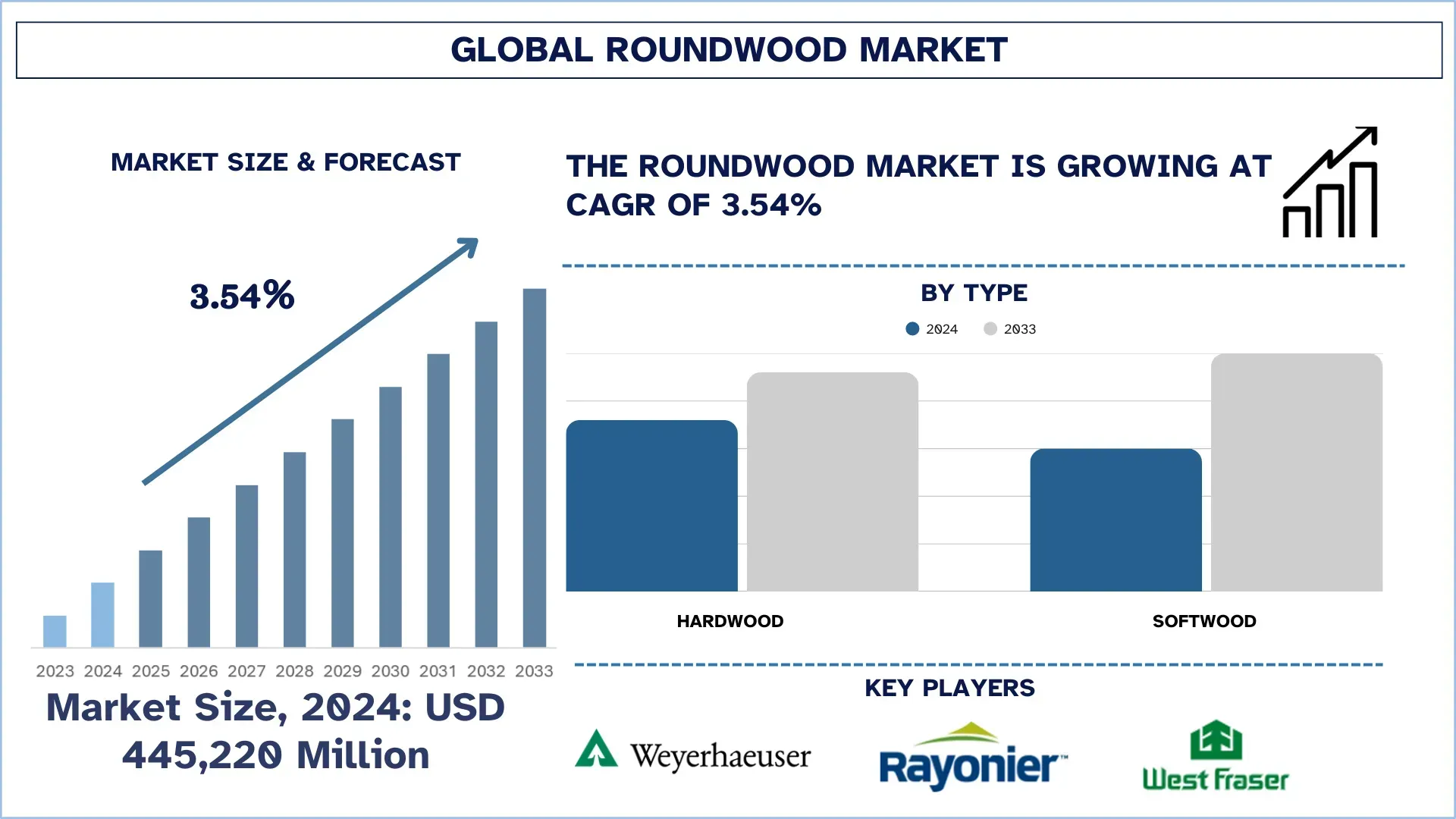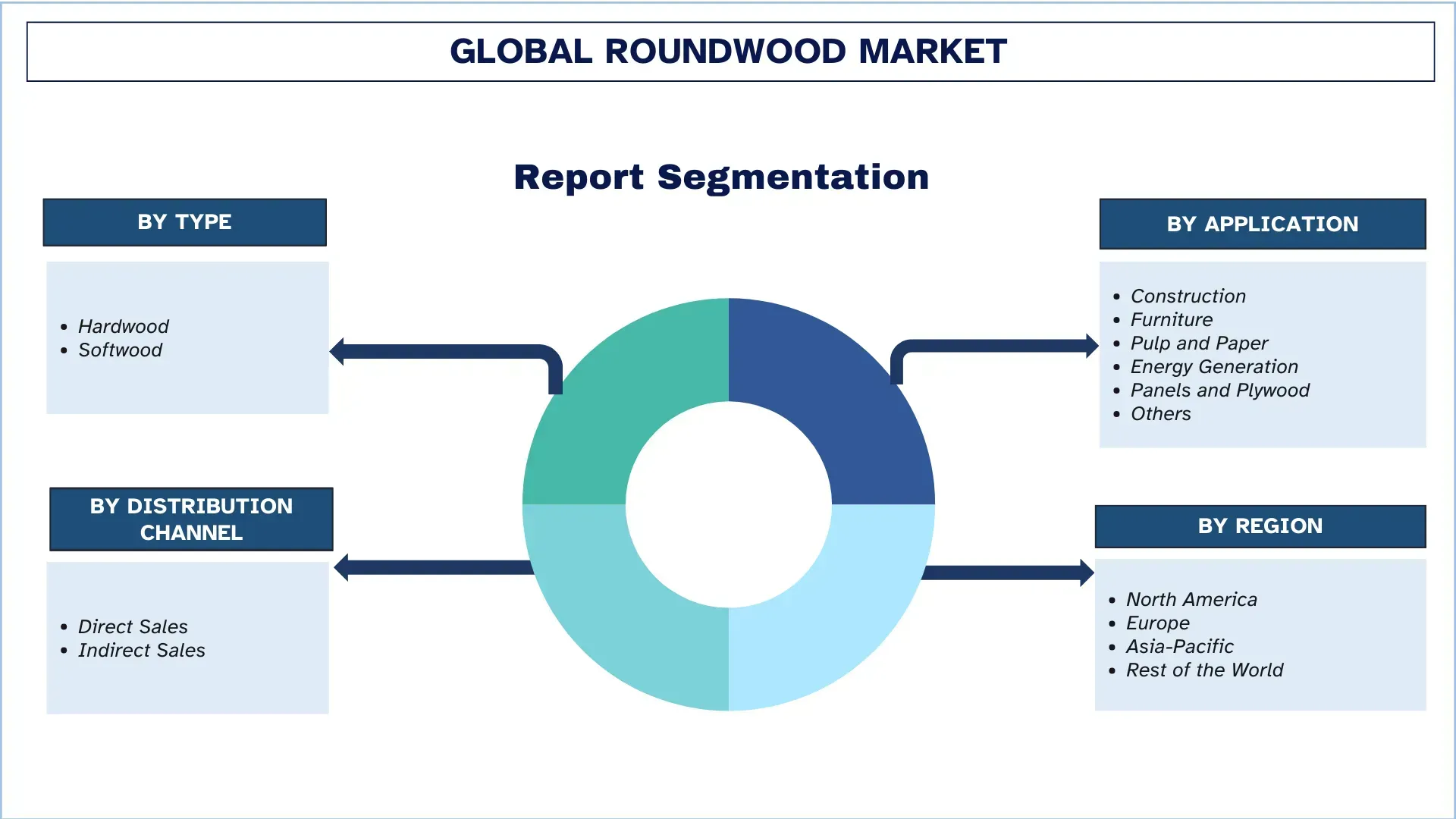- Home
- About Us
- Industry
- Services
- Reading
- Contact Us
Roundwood Market: Current Analysis and Forecast (2025-2033)
Emphasis on Type (Hardwood and Softwood); Application (Construction, Furniture, Pulp and Paper, Energy Generation, Panels and Plywood, and Others); Distribution Channel (Direct Sales and Indirect Sales); and Region/Country

Global Roundwood Market Size & Forecast
The Global Roundwood Market was valued at USD 4,45,220 million in 2024 and is expected to grow at a strong CAGR of around 3.54% during the forecast period (2025-2033F), driven by increasing demand for construction materials and furniture, growth in the paper and packaging industries, and rising interest in sustainable and renewable bioenergy sources.
Roundwood Market Analysis
Roundwood is the unprocessed timber directly extracted from trees that have been cut and have their original cross-section and appearance in a natural round shape. It can be made available in both hardwood and softwood, depending on the nature of the trees and the end-use specifications. This raw material is available in cubic meters and serves as a fundamental resource in various industries, including construction, furniture manufacturing, the paper industry, and renewable energy production.
Global demand for sustainable and renewable raw materials in various industries, including construction, furniture, paper, and bioenergy, is increasing, which contributes to the growth of the roundwood market. The growing urbanization and development of infrastructural projects are leading to an increase in the usage of timber, which fuels the roundwood market. Adding to this, growing concerns about the environment are driving the adoption of wood as a renewable source of building materials, replacing plastics and metals. The development of forestry management and certification increases sustainable timber harvesting and improves market confidence. Moreover, the development of the usage of biomass in energy production, and government incentives that promote these applications of renewable resources, catalyze further development of the market.
Global Roundwood Market Trends
This section discusses the key market trends that are influencing the various segments of the global roundwood market, as found by our team of research experts.
Growing Role of Carbon Credits in Forestry Economics
Carbon credits are becoming a significant trend in the forestry economy, shaping the roundwood market. With governments and corporations striving to reach net-zero, sustainably managed forests are being increasingly appreciated, not just as a source of carbon sequestration, but also in the context of timber production. Carbon credit trading now gives landowners an alternative source of revenue in addition to roundwood sales, as they can monetize carbon storage. This motivates sustainable forestry, reforestation, and lower levels of deforestation, which eventually leads to improved stability in long-term timber supply. Carbon markets are transforming forestry economics with their integration affecting investment approaches and resulting in the demand for certified and sustainably sourced roundwood.
Roundwood Industry Segmentation
This section provides an analysis of the key trends in each segment of the global roundwood market report, along with forecasts at the global, regional, and country levels for 2025-2033.
The Softwood Segment Dominates the Global Roundwood Market
Based on the type category, the market is categorized into hardwood and softwood. Among these, softwood has the highest market share in the roundwood market, as it is among the fastest-growing woods, highly available in nature, and used in industries as construction materials and the paper industry. It is usually less expensive and easier to process as compared with hardwood. However, in the future, hardwood can be predicted to grow at a more accelerated rate based on the rising demand for high-end furniture, flooring, and specialty products that need durability and aesthetic-related features.
The Construction Segment Dominates the Global Roundwood Market.
Based on the application category, the market is categorized into construction, furniture, pulp and paper, energy generation, panels and plywood, and others. Among these, the construction segment currently holds the largest market share since roundwood is actively used globally in the construction industry as a building material. The high demand for its use is facilitated by urbanization, infrastructure developments, and housing construction. However, the energy generation segment is expected to rapidly grow in the future, due to increased investments in renewable energy and bioenergy aimed at reducing carbon emissions.

Europe holds the largest market share in the global Roundwood market
Europe holds the largest market share in the global roundwood market since it has a vast amount of forest resources, a well-established timber market, and is strongly demanded in construction, furniture, and the paper industry. Europe has been practicing sustainable forest management mechanisms, and this means there are substantial reserves of high-quality roundwood. European countries, such as Germany, Sweden, and Finland, are also among the largest producers and exporters of roundwood, and they employ advanced processing technologies and have efficient supply chains. Also, strict environmental policies and certification bodies, e.g., FSC or PEFC, help increase the credibility and even the competitiveness of the market on a worldwide scale. Domestic consumption, which is already high, combined with strong export potential, ensures the market dominance of Europe in the international roundwood market.
Germany held a Dominant share of the Europe Roundwood Market in 2024
Germany has the largest market share in the Europe roundwood market and also has the record of sustainably harvesting their forests. Its well-developed wood processing sector, along with high domestic demand driven by construction, furniture manufacturing, and paper production, contributes to regular consumption. Germany is also a major exporter in the European continent, with a good logistical and strategic central position. There is sustainability and long-term supply stability, achieved through strict compliance with sustainable forest management under EU and national regulations. Moreover, the Government encourages bio-economy projects, which enhances German dominance in the roundwood market.

Roundwood Industry Competitive Landscape
The global roundwood market is competitive, with several global and international market players. The key players are adopting different growth strategies to enhance their market presence, such as partnerships, agreements, collaborations, geographical expansions, and mergers and acquisitions.
Top Roundwood Market Companies
Some of the major players in the market are Weyerhaeuser Company, Rayonier Inc., West Fraser Timber Co., Svenska Cellulosa AB (SCA), Holmen, Stora Enso, Green Diamond Resource Co., OneFortyOne, HVP Plantations, and Sumitomo Forestry Co., Ltd.
Recent Developments in the Roundwood Market
- In July 2025, James Jones & Sons announced the construction of its new industrial-scale sawmill in Durham, which represents the first large-scale facility of its kind to be built in the UK in decades. The development aims to boost domestic timber processing capacity, create new jobs, and strengthen the company’s production capabilities to meet growing demand in the UK timber market.
- In July 2025, British Columbia approved a new First Nations Woodland License in the Smithers area, created from timber rights shared by West Fraser and Lake Babine Nation Forestry. This license is expected to provide the Nation with a steady supply of roundwood and support a long-term, sustainable, Indigenous-led approach to managing local forests.
Global Roundwood Market Report Coverage
Details | |
Base year | 2024 |
Forecast period | 2025-2033 |
Growth momentum | Accelerate at a CAGR of 3.54% |
Market size 2024 | USD 4,45,220 million |
Regional analysis | North America, Europe, APAC, Rest of the World |
Major contributing region | The Asia-Pacific region is expected to dominate the market during the forecast period. |
Key countries covered | U.S., Canada, Germany, U.K., Spain, Italy, France, China, Japan, and India. |
Companies profiled | Weyerhaeuser Company, Rayonier Inc., West Fraser Timber Co., Svenska Cellulosa AB (SCA), Holmen, Stora Enso, Green Diamond Resource Co., OneFortyOne, HVP Plantations, and Sumitomo Forestry Co., Ltd. |
Report Scope | Market Trends, Drivers, and Restraints; Revenue Estimation and Forecast; Segmentation Analysis; Demand and Supply Side Analysis; Competitive Landscape; Company Profiling |
Segments Covered | By Type, By Application, By Distribution Channel, and By Region/Country |
Reasons to Buy the Roundwood Market Report:
- The study includes market sizing and forecasting analysis confirmed by authenticated key industry experts.
- The report briefly reviews overall industry performance at a glance.
- The report covers an in-depth analysis of prominent industry peers, primarily focusing on key business financials, type portfolios, expansion strategies, and recent developments.
- Detailed examination of drivers, restraints, key trends, and opportunities prevailing in the industry.
- The study comprehensively covers the market across different segments.
- Deep dive regional level analysis of the industry.
Customization Options:
The Global Roundwood Market can further be customized as per the requirements or any other market segment. Besides this, UnivDatos understands that you may have your own business needs; hence, feel free to contact us to get a report that completely suits your requirements.
Table of Content
Research Methodology for the Global Roundwood Market Analysis (2023-2033)
We analyzed the historical market, estimated the current market, and forecasted the future market of the global roundwood market to assess its application in major regions worldwide. We conducted exhaustive secondary research to gather historical market data and estimate the current market size. To validate these insights, we carefully reviewed numerous findings and assumptions. Additionally, we conducted in-depth primary interviews with industry experts across the roundwood value chain. After validating market figures through these interviews, we used both top-down and bottom-up approaches to forecast the overall market size. We then employed market breakdown and data triangulation methods to estimate and analyze the market size of industry segments and sub-segments.
Market Engineering
We employed the data triangulation technique to finalize the overall market estimation and derive precise statistical numbers for each segment and sub-segment of the global roundwood market. We split the data into several segments and sub-segments by analyzing various parameters and trends, including type, application, distribution channel, and regions within the global roundwood market.
The Main Objective of the Global Roundwood Market Study
The study identifies current and future trends in the global roundwood market, providing strategic insights for investors. It highlights regional market attractiveness, enabling industry participants to tap into untapped markets and gain a first-mover advantage. Other quantitative goals of the studies include:
Market Size Analysis: Assess the current and forecast market size of the global roundwood market and its segments in terms of value (USD).
Roundwood Market Segmentation: Segments in the study include areas of type, application, distribution channel, and region.
Regulatory Framework & Value Chain Analysis: Examine the regulatory framework, value chain, customer behavior, and competitive landscape of the roundwood industry.
Regional Analysis: Conduct a detailed regional analysis for key areas such as Asia Pacific, Europe, North America, and the Rest of the World.
Company Profiles & Growth Strategies: Company profiles of the roundwood market and the growth strategies adopted by the market players to sustain the fast-growing market.
Frequently Asked Questions FAQs
Q1: What is the global roundwood market’s current market size and growth potential?
As of 2024, the global roundwood market is valued at USD 4,45,220 million and is projected to grow at a notable CAGR of 3.54% from 2025 to 2033. This growth is driven by increasing demand across the construction, furniture, and paper industries, alongside a rising focus on sustainable forestry practices.
Q2: Which segment has the largest share of the global roundwood market by type category?
The softwood segment holds the largest share of the global roundwood market, owing to its cost-effectiveness, versatility, and widespread use in construction, packaging, and pulp production.
Q3: What are the driving factors for the growth of the global roundwood market?
Top growth drivers of the roundwood market include:
• Rapid construction and infrastructure expansion
• Rising demand for certified, sustainable wood products.
• Technological innovations and improved forestry certifications.
Q4: What are the emerging technologies and trends in the global roundwood market?
Emerging trends in the roundwood market include:
• The growing role of carbon credits in forestry economics.
• Increasing localization of supply chains to improve resilience.
Q5: What are the key challenges in the global roundwood market?
Key challenges in the roundwood market include:
• Geopolitical tensions and supply chain disruptions.
• Environmental concerns over deforestation and biodiversity loss.
Q6: Which region dominates the global roundwood market?
Europe dominates the global roundwood market due to its advanced forestry management practices, strong demand for sustainable timber, and robust wood-processing industries.
Q7: Who are the key competitors in the global roundwood market?
Top players in the Roundwood industry include:
• Weyerhaeuser Company
• Rayonier Inc.
• West Fraser Timber Co.
• Svenska Cellulosa AB (SCA)
• Holmen
• Stora Enso
• Green Diamond Resource Co.
• OneFortyOne
• HVP Plantations
• Sumitomo Forestry Co., Ltd.
Q8: What is the expected demand outlook for roundwood in the construction sector?
The construction sector is projected to remain a major consumer of roundwood, fueled by urbanization, infrastructure upgrades, and the growing adoption of timber-based green building solutions.
Q9: How is sustainability influencing investment opportunities in the roundwood market?
Sustainability is becoming a key investment driver, with growing emphasis on certified timber, reforestation initiatives, and carbon credit opportunities, attracting both private and institutional investors.
Related Reports
Customers who bought this item also bought










